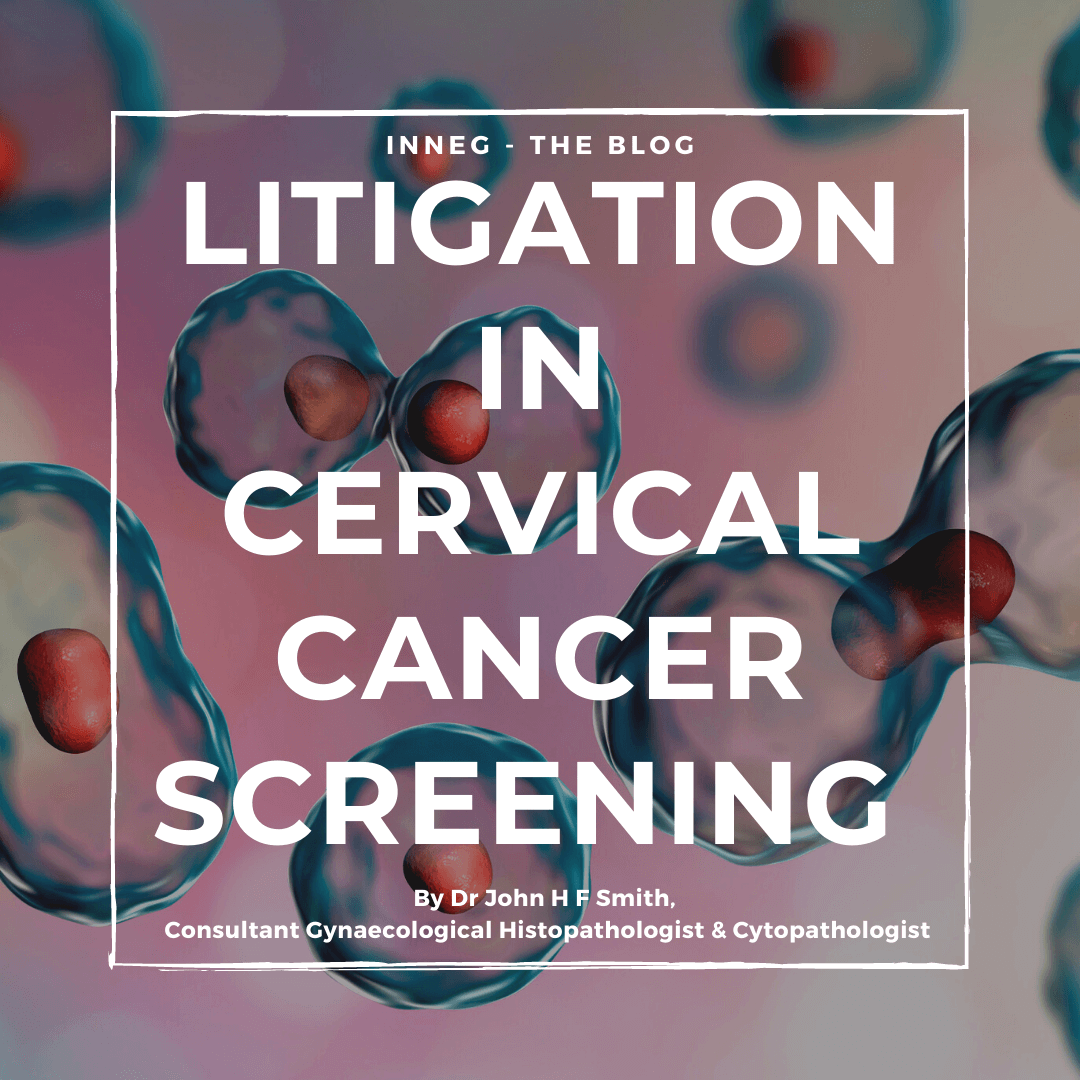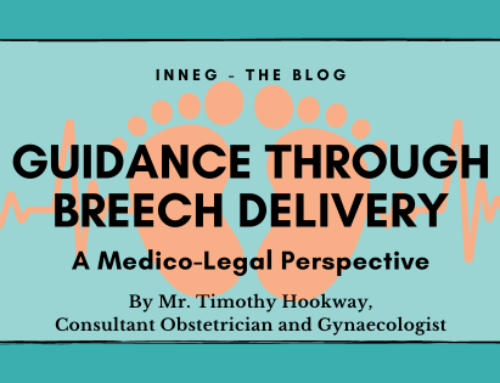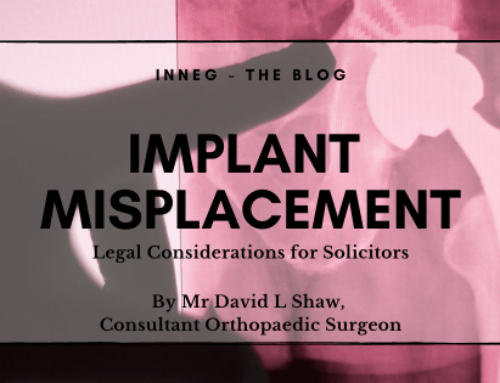Litigation in Cervical Cancer Screening
By Dr John HF Smith, Consultant Gynaecological Histopathologist & Cytopathologist
Globally cervical cancer (cancer of the neck of the womb) remains a major public health problem accounting for over half a million (570,000) new cases and 311,000 deaths in 2018.
It is the fourth most common cancer in women after breast, bowel (colorectal) and lung cancer. About 80% of cases are squamous carcinoma [tumours arising from the squamous epithelium on the outside of the cervix and the transformation zone] and the remainder adenocarcinoma [tumours arising from the glandular epithelium lining the upper part of the cervix, called the endocervix]. However the global age standardised incidence (the number of new cases in a population in a given time period) of 13.1 cases per 100,000 women varies enormously from <2 to 75 per 100,000 and this is explained by variance in sexual behaviour in different cultures and countries and the presence of cytology based cervical screening programmes particularly in Europe, North America and Australasia. 1
Cytology based cervical cancer screening programmes, such as that in the UK, are dependent on detection and identification of abnormal cells indicative of the presence of cervical pre-cancer by microscopic examination of a sample of cells obtained from the cervix (the cervical smear test). In England women are invited for their first cervical screening test at the age of 25 years, thereafter at 3 yearly intervals until age 50, and thereafter at 5 yearly intervals until age 65 when screening stops.
An Intro to Cervical Cancer Screening
In the UK microscopic examination of the sample obtained in a laboratory is first undertaken by a trained laboratory professional known as a cytology screener, and if this individual does not identify any abnormal cells the slide is passed to a second screener to be examined. If this individual does not identify any abnormal cells, then the sample is reported as negative (normal) and a report issued with a recommendation to repeat the test in 3 or 5 years dependent on the woman’s age. If at any stage abnormal squamous or glandular cells are suspected or identified, the slide is passed to a more highly trained member of staff usually a consultant biomedical scientist or a medically qualified pathologist. If the consultant biomedical scientist or pathologist agrees that abnormal squamous or glandular cells are present, he or she will issue a report indicating the degree of abnormality and make an appropriate recommendation. The recommendation will be either to repeat the test in 3 to 6 months if low-grade abnormality is present or to refer the woman for colposcopy if high-grade abnormality or persisting low-grade abnormality is present.
Colposcopy is an examination, usually performed by a gynaecologist or clinical nurse specialist, using a colposcope, an instrument which provides a magnified and illuminated view of the cervix. The colposcope allows the gynaecologist or clinical nurse specialist to visually distinguish normal from abnormal appearing tissue, evaluate such abnormal changes in the tissue and take directed biopsies for pathological (microscopic) examination. Subject to the results of the biopsies and the colposcopist’s opinion about the extent of the abnormal tissue, the abnormal tissue may be removed by an excisional procedure, either a large loop excision of the transformation zone (LLETZ) or a knife cone biopsy. These excisional biopsies are also sent for pathological (microscopic) examination in order to determine the extent of any pre-cancerous changes, the presence of squamous carcinoma or adenocarcinoma, and whether the pre-cancerous changes and/or carcinoma have been completely removed.
Prior to 2004, cervical cytology samples were obtained by scraping a sample of cells from the cervix using a wooden spatula, the material on the spatula spread on to a glass slide (hence the test became known as the smear test), fixed on the slide by dipping it in alcohol, and the slide submitted to the laboratory for microscopic examination. From 2004 onwards the UK cervical screening programme progressively moved to liquid based cytology whereby the sample was collected by a small brush
in essentially the same way as for a conventional smear test but rather than the cell sample being transferred directly to a microscope slide, it was deposited into a small bottle of preservative liquid. At the laboratory, the liquid is treated to remove other elements such as mucus before a layer of cells is placed on a slide. The technique improved specimen adequacy and the detection of precancerous cells, and offered the ability to perform molecular (i.e., hrHPV vide infra) testing and, possibly in the future, digital image analysis. All the United Kingdom cervical screening programmes had changed from the conventional smear test to liquid-based cytology by 2008 using one or other of the two commercially available systems for preparation of liquid based cytology samples, called SurePath™ and ThinPrep®.
More recently, based on the knowledge that high risk human papilloma virus (hrHPV) infection is the principal cause of both squamous carcinoma and adenocarcinoma of the cervix, coupled with the successful implementation of an HPV vaccination programme for girls aged 12-13 years which will unquestionably result in a reduction in the incidence of cervical cancer and its precursor lesions known as CIN (cervical intraepithelial neoplasia) for squamous carcinoma and CGIN (cervical glandular intraepithelial neoplasia) for adenocarcinoma, and following clinical trials, the UK screening programmes have modified the way in which they handle cervical smear tests. With effect from January 2020, whilst the cervical screening samples are taken in exactly the same way as previously, all are first tested for hrHPV and only those that test positive for hrHPV subjected to microscopic examination. This will significantly reduce the number of samples that need to be microscopically examined by up to 85% and in anticipation of this change in practice in late 2019 the 58 NHS laboratories reporting cervical screening samples were amalgamated and consolidated to eight regional laboratories, all of which now only use the ThinPrep® system.
Cervical Cytology Litigation
Litigation may occur at any stage of the cervical screening programme from the invitation to participate to colposcopy and treatment but the rest of this article will concentrate on issues with cervical cytology slide evaluation as in my experience they constitute the majority of potential claims.
Microscopic examination of cervical cytology samples is not a perfect laboratory test with recognised false negative and false positive results, reflected in the reported sensitivity and specificity of liquid based cytology as 53 – 83% and 73 – 83% respectively.2 In other words between 53 – 83% of women who have cervical pre-cancer (CIN or CGIN) will give a “true positive” result and the remaining 47-17% a “false negative” result, and 73 – 83% of women who do not have cervical pre-cancer will give a “true negative” result and the remaining 27 – 17% a “false positive” result.
It has long been recognised that false negative conventional cervical smears were characterised by those in which there were a few, if any, large abnormal cell groups; few detached abnormal or obviously malignant cells; unevenly distributed abnormal cells, which were often at the edge of the sample on the microscope slide; abnormal cells with small nuclei and minimal abnormality of the nucleus; and, abnormal cells with pale staining nuclei.3-6 More recently in my former laboratory and others, the issue of false negative liquid based cervical cytology preparations in both the SurePath™ and ThinPrep® systems has been addressed.
In my former laboratory we undertook an audit of false-negative reports in SurePath™ cervical cytology over a period of five years.7 We identified 481 false negative reports (0.3%) in a workload totalling 183,112 samples either by routine laboratory internal quality control or those samples reported as negative with concurrent high grade cervical histology (high-grade CIN, CGIN or cancer) . Of 95 samples with a subsequent biopsy reported as at least high grade CIN or CGIN, 30.5% predominantly contained dark staining (hyperchromatic) crowded cell groups, 27.3% sparse (<30) dyskaryotic (abnormal) cells, 4.2% pale cell dyskaryosis, 6.3% small dyskaryotic cells; 3.2% were misinterpreted cells; 8.4% contained other distracting cells; 7.4% were low contrast; 5.3% were unexplained; and 7.4% were true negatives. The mean number of abnormal cells in the sparse dyskaryotic cell category was 13.8. To put the latter figure in context it equates to one cell in 23 to one cell in 56 in each microscopic field of view: overall the screener may be looking for one abnormal cell in 1666 – 2333 cells – a veritable cytological needle in a haystack!7
Similarly, colleagues in Hong Kong reported that 79% of false negative ThinPrep® cervical cytology slides had 100 or less abnormal cells on the slide, while only 11% of true positive ThinPrep® cervical cytology slides had 100 or less abnormal cells. The true positive slides were also more likely to contain koilocytic cells (those showing evidence of HPV infection) and abnormal cells with dark staining (hyperchromatic) nuclei. The number of abnormal cells present, the presence or absence of koilocytic cells, and the presence or absence of abnormal cells with dark staining nuclei appeared to be independent factors affecting the correct prediction of samples from patients with high-grade CIN.8
Cervical cancer screening in the UK is subject to rigorous external quality assurance (EQA) and internal quality control (IQC) at all stages of the process and compliance with EQA and IQC is expected and periodically evaluated.
Furthermore all cases of cervical cancer in England are subjected to a mandatory audit, undertaken to a standard national protocol. Women are offered the results of this audit which reviews the entire screening pathway prior to the diagnosis of cervical cancer. Whilst the intention of the audit has always been educational, in reality litigants may use the results of the audit to initiate a medicolegal action: for example, if the audit review reveals that abnormal cells are present on a slide previously reported as normal or that a cervical biopsy has been misreported.
Medicolegal practice in cervical cytology is still influenced by the High Court judgement in relation to failure to identify abnormal cells in conventional cervical smears at the cervical cytology laboratory at the Kent and Canterbury Hospital in the 1990s, as a result of which at least eight women died and 90,000 were recalled for repeat tests after screening errors led to the early signs of cancer in some tests being missed.9 Many litigation cases that followed were settled but the cases of three women with subtle cytological abnormality were challenged and subsequently referred to the Court of Appeal, which resulted in a judgement introducing the “absolute confidence” test that a sample could not be reported as negative at screening in the absence of absolute certainty that no abnormal cells were present. 10,11
The “absolute confidence” test has made it difficult to defend any case where an expert has identified abnormal cells missed at the screening stage, and most such cases are settled. The only exception is when the abnormal cells are few in number as described above.12
About the Author:
Dr John HF Smith, BSc (Hons), MB. BS. (Hons), FRCPath., MIAC. was Consultant Histopathologist and Cytopathologist at the Northern General Hospital, Sheffield from 1987 to 2001 and following at the Royal Hallamshire Hospital, Sheffield until 2020. Dr Smith was also an Honorary Senior Clinical Lecturer in Pathology in the University of Sheffield.
From 1988 he took the lead role in gynaecological histopathology and cervical cytology in Sheffield amd from 1998 practiced exclusively in gynaecological histopathology and cervical cytology being the lead histopathologist at the Sheffield Gynaecological Cancer Centre between 2001-16.
From 1990 to 2019 he was Director of the North of England Pathology and Screening Education Centre (which he founded as Sheffield Cytology Training Centre in 1990), and from 2004 -19 Director of South Yorkshire and Bassetlaw Cervical Cytology Service, responsible for a cytology laboratory reporting approximately 110,000 cervical cytology samples per annum.
He is a member of the British Association of Gynaecological Pathologists (BAGP), the British Association for Cytopathology (BAC) (formerly the British Society for Clinical Cytology (BSCC)), the British Society for Colposcopy and Cervical Pathology (BSCCP), and the International Society of Gynecological Pathologists.
He is a past Examiner in Histopathology and Cytopathology of the Royal College of Pathologists (RCPath), a past Chair of the Cytopathology Sub-Committee of the RCPath, a past Chairman of the Panel of Examiners in Cytology of the RCPath, and a past President of the BSCC.
He has served at various times on working parties and advisory committees of the GMC, RCPath, BSCC, BAGP, BAC, Clinical Pathology Accreditation (UK) Ltd, the National Health Service Cervical Screening Programme (NHSCSP), Public Health England and the International Academy of Cytology (IAC).
From 2013-2019 he was Vice President of the IAC and was awarded The Maurice Goldblatt Cytology Award 2017 of the International Academy of Cytology in recognition of his contribution to cervical cytology practice and education.
References
- Arbyn M. Estimates of incidence and mortality of cervical cancer in 2018. Lancet Global Health 2020; 8: e191-203
- Karnon J. Health Technology Assessment Report for NICE. 2003
- Bosch MM, Rietveld-Scheffers PE, Boon ME. Characteristics of false-negative smears tested in the normal screening situation. Acta Cytologica 1992; 36: 711
- Robertson & Woodend. Negative cytology preceding cervical cancer: causes and prevention. Journal of Clinical Pathology 1993; 46: 700-702
- Mitchell H & Medley G. Differences between Papanicolaou smears with correct and incorrect diagnoses. Cytopathology 1995; 6: 368-375
- Baker RW, O’Sullivan JP, Hanley J, Coleman DV. The characteristics of false negative cervical smears – implications for the UK cervical cancer screening programme. Journal of Clinical Pathology 1999; 52: 358-362
- Gupta N, John D, Dudding N, Crossley J, Smith JHF. Factors contributing to false-negative and potential false-negative cytology reports in SurePath™ liquid-based cervical cytology. Cytopathology 2013; 24: 39-43
- Leung KM, Lam KK, Tse G, Yeoh PS, Chan KW. Characteristics of false-negative ThinPrep cervical smears in women with high-grade squamous intraepithelial lesions. Hong Kong Medical Journal 2008; 14: 292-295
- Wells W. Review of Cervical Screening Services at Kent and Canterbury Hospitals NHS Trust. London, United Kingdom: NHS Executive South Thames; 1997
- Penny, Palmer and Cannon v East Kent Health Authority. (QBD (Canterbury): Judge Peppitt QC, February 15 1999
- Penny and others v East Kent Health Authority. Court of Appeal (Civil Division). Case no: QBENF1999/0294/1. 16 November 1999
- Denton K. Cervical screening, cytology and histology laboratory issues. In: Jha S and Ferriman E (Eds). Medicolegal Issues in Obstetrics and Gynaecology. Springer International Publishing AG. 2018: 345 – 349






